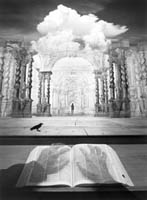The Andrew Smith Gallery welcomes Jerry Uelsmann, the master of montage photography, back to Santa Fe for an exhibit of new silver print photographs. The exhibit titled, .JERRY UELSMANN: Other Realities, opens Friday, Nov. 11, 2005, with a reception for the artist from 5 to 7 p.m. Jerry Uelsmann is one of America's most important contemporary photographers, known throughout the world for his dream-like scenes created by hand printing multiple negatives on single sheets of paper that challenge conventional notions of reality. Jerry Uelsmann is credited with changing the language and directions of photography. Since the late 1950s his composite, surreal photographs have evoked myth, magic, humor, and melancholy. His enigmatic images of nature, the human figure, exterior and interior environments, and human relationships can be viewed as personal symbols, as well as doorways into the collective psyche. The exhibit continues through January 15, 2006.
The photographs in the exhibit were made between 1998 and 2005, and appear in the new book, Jerry Uelsmann: Other Realities (Bulfinch Press, New York, 2005). On Saturday, Oct. 12 from 1 to 4 p.m. Jerry Uelsmann and his wife, the photographer Maggie Taylor, will be at Verve Fine Arts at 219 E. Marcy Street, Santa Fe for a joint book signing. The show at Verve is called Beyond the Ordinary. For more information about the book signing please call Verve at 505-982-5009 or email vervefinearts.com.
Once considered iconoclastic, Uelsmann's photographs now have their place within classic photography traditions. Inspired by his teachers Ralph Hattersley, Minor White, Beaumont Newhall, and Henry Holmes Smith, Uelsmann set out to convince critics that photography offered alternatives to the conventional "purist" sensibility that had driven the medium since the time of Alfred Stieglitz and Paul Strand. Photographs, Uelsmann argued, could do more than merely describe literal objects and scenes; they could evoke elusive states of feeling and thinking triggered by irrational and imaginative juxtapositions of disparate images. According to photo-historian Peter C. Bunnell, Uelsmann retraced the footsteps of the nineteenth century photographers H.P. Robinson and O.G. Rejlander who created pictures by combining photographic bits and pieces.
In an era of facile Photo-Shop technology Uelsmann still uses up to seven enlargers in the darkroom, laboriously printing seamless images from multiple negatives. For him, darkroom work is a constant process of search and discovery; the antithesis of the "previsualization" approach used by Ansel Adams and Edward Weston who calculated in advance what the photographic image should look like. Uelsmann prefers the term "postvisualization" to describe the hybridized style of image-making that is uniquely his own.
 "Dream Theater, 2004" "Dream Theater, 2004"
In the words of Peter C. Bunnell, Uelsmann "sets himself and us on a journey without a map." In "Dream Theater, 2004" ghostly hands claw at an open dictionary on a table, as if struggling to define the surreal scene that is the content of the image. In an elaborate stage set of Baroque columns, statuary, and archways a nude woman is exiting. The roof of this fantastic structure dissolves into billowing white clouds while on the floor a raven is perched, suggesting perhaps sorrow and loss, like Poe's raven lamenting the lost Lenore.
"Untitled, 2003"
In the center of a serene lake bounded by soft, pine covered mountains two large, luminous hands rise out of the dark water. Their cupped palms hold concentric circles of clear water, as if a stone has been dropped in there. The scene is exquisitely tranquil, except for the enigma of a tiny house in the distance that floats uncertainly on the still waters. Uelsmann's flawless printing technique makes it difficult to discern what part of the photograph is manipulated and what is straight.
 "Meditation Mystery, 2001" "Meditation Mystery, 2001"
Clouds and ocean swirl around a sunburst shining through vapors as a lone seagull soars between the sea and sky. On the surface of the ocean a dark, crooked ladder emerges (or descends) from a hole in the water. The polarities conveyed by "Meditation Mystery" will suggest different things to different viewers. "I am involved," writes Uelsmann, " with a kind of reality that transcends surface reality. More than physical reality, it is emotional, irrational, intellectual, and psychological."
 "Untitled, 2004" "Untitled, 2004"
Uelsmann's photographs create dramatic, impossible moments in which events that shouldn't and couldn't be together occupy the same space. In "Untitled, 2004" a rowboat is being capsized by rushing waves. Only its bow, pointing toward the sun, is visible above the churning waters. The twist is that the boat rests on a walled pier. The violence of the shipwreck contrasts with a scene of a calm harbor filled with small boats and a row of houses on a far shore. Bridging the two vastly different scenes is a man standing in the water who gazes helplessly at the destroyed boat.

"Homage to John Muir, 2004"
The finely printed photograph of a clear mountain lake in Yosemite bounded by rocks and trees is reminiscent of a landscape by Ansel Adams or Carlton Watkins. But Uelsmann humorously transforms the scene into an oblique portrait of the great naturalist John Muir who was instrumental in creating Yosemite National Park in the 1800s. By hand printing multiple negatives Uelsmann shows a partially submerged rock on which rests an old book. On its cover is a photograph of an eye, suggesting a consciousness that sees and thinks deeply about this particular place.
Jerry Uelsmann was born in Detroit in 1934. He studied photography at Rochester Institute of Technology and Indiana University. His numerous books include Jerry Uelsmann: Photo Synthesis (University Press of Florida, 1992), Uelsmann: Process and Perception (University Presses of Florida, 1985), and Jerry N. Uelsmann (An Aperture Monograph New York, 1971). His work is in major museum collections through the world. Mr. Uelsmann has retired from teaching at the University of Florida, Gainesville where he taught since 1960. He continues to photograph and lecture about his work.
Liz Kay |